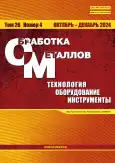Introduction. Roller burnishing is one of the most popular methods for improving the surface quality of a workpiece, increasing its wear resistance, microhardness and corrosion resistance. During the processing, the workpiece is compressed and smoothed under the pressure of hardened roller. Purpose of the work. The results of the research show that the introduction of minimum quantity lubrication (MQL) during roller burnishing makes it possible to increase the efficiency of the process by reducing friction and improving lubrication. Studies have shown that the use of nanofluids under MQL conditions improves the machining performance. However, very little attention has been paid to the roll burnishing of Al6061-T6 alloy under nano minimum quantity lubrication (NFMQL) conditions. The methods of investigation. In light of this, this study compares the performance of roll burnishing of Al6061-T6 alloy under dry friction conditions and NFMQL conditions. The microhardness, roundness, and surface roughness are evaluated, modeled, and optimized in the study by considering the cutting speed, feed rate, and number of passes. Based on the experimental results, mathematical models are established to predict the surface roughness, microhardness, and roundness deviation. Results and Discussion. The developed models of surface roughness, microhardness and roundness deviation show the R-square value higher than 0.9, which allows these models to be confidently used to predict the studied responses under dry friction conditions and under NFMQL conditions within the parameter domain selected in this work. According to this study, the machining performed in four passes at a cutting speed of 357 rpm and a tool feed of 0.17 mm/rev can obtain the lowest roundness deviation (3.514 μm), the best microhardness (130.19 HV) and the lowest surface roughness (0.64 μm). Further, the study shows that increasing the number of passes (more than four) does not lead to a significant improvement in surface roughness or microhardness. However, it leads to a slight increase in roundness deviation. Therefore, it is recommended to use a maximum of four passes during roll burnishing of Al6061-T6 aluminum alloy specimens under dry friction conditions to achieve optimal results. The obtained results imply that roller burnishing can effectively improve the overall surface quality and hardness of the workpiece. In addition, roller burnishing is regarded as an affordable method to enhance the functionality and strength of the machined parts by reducing the occurrence of surface defects such as scratches and cracks. It is found that the surface roughness decreases with the increase of the cutting speed. However, it is observed to increase under both dry friction and NFMQL conditions when the cutting speed is increased to 360–380 rpm. Moreover, it is found to decrease with the increase of the feed and the number of passes. But after three or four passes at a feed rate of 0.2–0.25 mm/rev, a noticeable increase in the surface roughness is observed. It is noticed that with the increase of the feed, the microhardness and the roundness deviation increase. In addition, as the number of passes increases, the roundness deviation decreases and the microhardness increases. The number of passes under dry friction condition and feed rate under NFMQL rolling has significant effects on the surface roughness. The cutting speed seems to have the greatest effect on the microhardness, followed by feed rate and the number of passes. On the other hand, the effect of increasing microhardness under NFMQL conditions seems to be stronger. Under dry friction condition, the cutting speed has a significant effect on the roundness deviation, and under NFMQL conditions, the feed rate has an effect.
 6-18
6-18


 19-40
19-40


 41-56
41-56


 57-74
57-74


 75-91
75-91


 92-111
92-111


 112-124
112-124


 125-137
125-137


 138-152
138-152


 153-179
153-179


 180-191
180-191


 192-205
192-205


 206-217
206-217


 218-233
218-233







